 Amazake
Amazake literally translates to "sweet sake" which is deceiving considering it's non-alcoholic. It's sweet, milky and easy to digest, making it perfect for kids or adults with an upset stomach.
Amazake is made by combining koji with cooked rice, which allows the rice to break down into simple sugars. This is the first step to sake-making. After this step, making sake involves fermentation, pasteurization and filteration and achieves an ABV of around 15%. Because amazake never goes through the fermentation process of 3-4 weeks it doesn't contain any alcohol. Amazake is said to be good for digestion because it helps break down proteins and complex carbohydrates. It's also believed to be a good hangover cure. And because it doesn't contain any alcohol, it is served to kids as a celebratory drink for special occasions like Girl's Day (March 3) and New Year's.
Making amazake is simple as long as you have an appliance that can maintain a low, steady temperature of 120-140˚F for up to 24 hours and can buy koji (
aspergillus oryzae) and rice. That said, it took me three tries to make an amazake I would feel proud to serve at our "
Umami Mart Hinamatsuri". (Shameless plug: Please come to Umami Mart this Friday 6-8pm to try my amazake!).
For my first attempt, I used my crock-pot on the "Low" setting, but it ended up burnt to a crisp. FAIL.
Then I remembered I had a yogurt-maker that my friends Laura and Will gave to me over a year ago. Jack pot! I think people also use a cooler with some hot water bottles in it or a dehydrator to maintain that 120-140˚F temperature. Finding the right place to incubate your amazake is probably the hardest part of making this drink. But with the yogurt-maker, I was ready to go. I used brown rice and koji and although it turned out okay, I didn't like how it was a little too rustic-tasting. The rice kernels were too firm and the brown rice over-powered the faint sweetness. That said, amazake made with brown rice has more vitamins than white rice. Sacrifices...
So for my third attempt, I decided to go with white rice. I used the "porridge" setting on my rice cooker then combined it with koji into the yogurt maker. SUCCESS! The result was milkier, sweeter and cleaner tasting than the brown rice trial.
Other applications for amazake include using it as a sweetener (instead of honey) or adding it as a topping to desserts.
So here is my final successful recipe for making amazake.
1 cup short grain white rice
2.5 cups water
2 cups dry koji (I used Cold Mountain brand which they sell at Japanese markets and health food markets -- including Whole Foods, where it will cost you an arm and a leg)
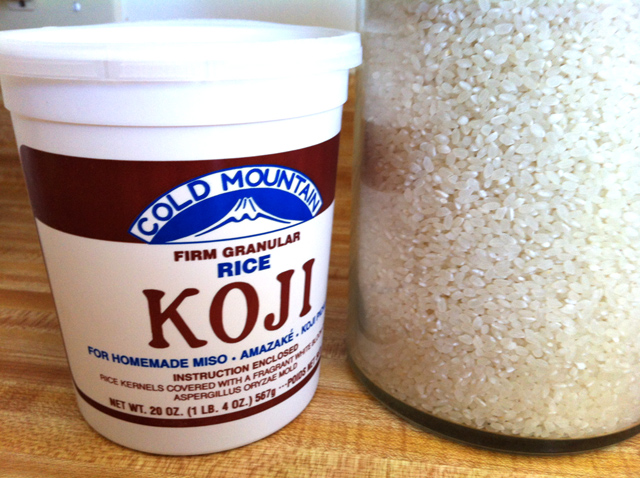
1. Steam white rice to porridge consistency.
2. Set up your low temperature appliance (120-140˚F) by plugging it in or preparing a cooler with hot water bottles.
3. Mix the koji into the rice.
4. Put the mixture into a wide mouth glass jar and place into the low temperature appliance for 14-24 hours.
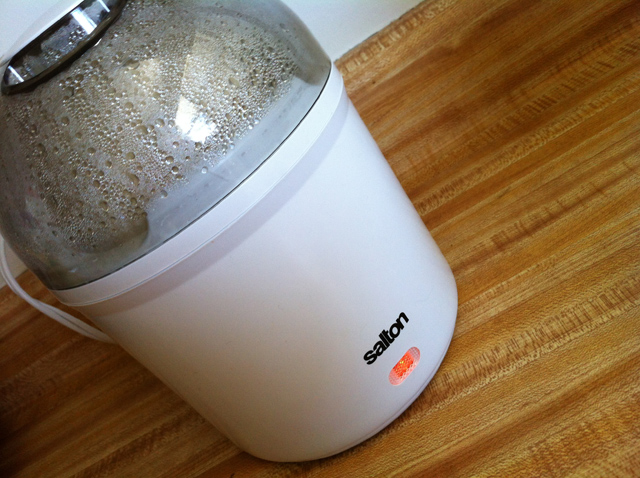
5. The amazake is ready when the rice grains are very soft and the koji is broken down. The amazake should be sweet and mildly syrupy.
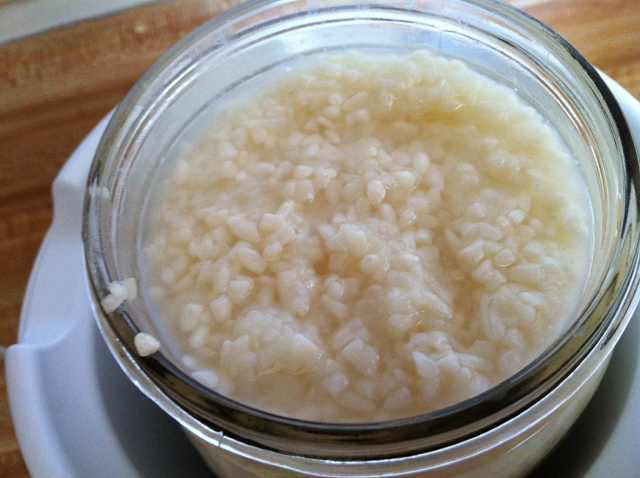
6. To enjoy as a hot amazake drink, add equal parts water and bring to a soft boil. Add some ginger as a topping.
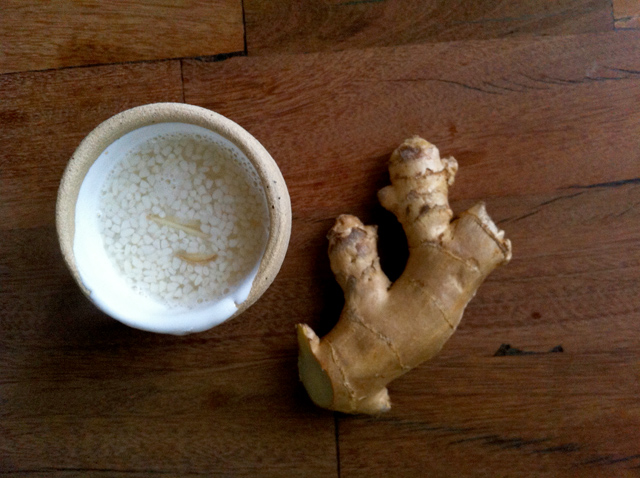
This is a very cozy drink, perfect for when you want to curl up in front of the TV after a heavy meal. It's also gluten-free, vegan and dairy-free!
 Amazake literally translates to "sweet sake" which is deceiving considering it's non-alcoholic. It's sweet, milky and easy to digest, making it perfect for kids or adults with an upset stomach.
Amazake is made by combining koji with cooked rice, which allows the rice to break down into simple sugars. This is the first step to sake-making. After this step, making sake involves fermentation, pasteurization and filteration and achieves an ABV of around 15%. Because amazake never goes through the fermentation process of 3-4 weeks it doesn't contain any alcohol. Amazake is said to be good for digestion because it helps break down proteins and complex carbohydrates. It's also believed to be a good hangover cure. And because it doesn't contain any alcohol, it is served to kids as a celebratory drink for special occasions like Girl's Day (March 3) and New Year's.
Making amazake is simple as long as you have an appliance that can maintain a low, steady temperature of 120-140˚F for up to 24 hours and can buy koji (aspergillus oryzae) and rice. That said, it took me three tries to make an amazake I would feel proud to serve at our "Umami Mart Hinamatsuri". (Shameless plug: Please come to Umami Mart this Friday 6-8pm to try my amazake!).
For my first attempt, I used my crock-pot on the "Low" setting, but it ended up burnt to a crisp. FAIL.
Then I remembered I had a yogurt-maker that my friends Laura and Will gave to me over a year ago. Jack pot! I think people also use a cooler with some hot water bottles in it or a dehydrator to maintain that 120-140˚F temperature. Finding the right place to incubate your amazake is probably the hardest part of making this drink. But with the yogurt-maker, I was ready to go. I used brown rice and koji and although it turned out okay, I didn't like how it was a little too rustic-tasting. The rice kernels were too firm and the brown rice over-powered the faint sweetness. That said, amazake made with brown rice has more vitamins than white rice. Sacrifices...
So for my third attempt, I decided to go with white rice. I used the "porridge" setting on my rice cooker then combined it with koji into the yogurt maker. SUCCESS! The result was milkier, sweeter and cleaner tasting than the brown rice trial.
Other applications for amazake include using it as a sweetener (instead of honey) or adding it as a topping to desserts.
So here is my final successful recipe for making amazake.
1 cup short grain white rice
2.5 cups water
2 cups dry koji (I used Cold Mountain brand which they sell at Japanese markets and health food markets -- including Whole Foods, where it will cost you an arm and a leg)
Amazake literally translates to "sweet sake" which is deceiving considering it's non-alcoholic. It's sweet, milky and easy to digest, making it perfect for kids or adults with an upset stomach.
Amazake is made by combining koji with cooked rice, which allows the rice to break down into simple sugars. This is the first step to sake-making. After this step, making sake involves fermentation, pasteurization and filteration and achieves an ABV of around 15%. Because amazake never goes through the fermentation process of 3-4 weeks it doesn't contain any alcohol. Amazake is said to be good for digestion because it helps break down proteins and complex carbohydrates. It's also believed to be a good hangover cure. And because it doesn't contain any alcohol, it is served to kids as a celebratory drink for special occasions like Girl's Day (March 3) and New Year's.
Making amazake is simple as long as you have an appliance that can maintain a low, steady temperature of 120-140˚F for up to 24 hours and can buy koji (aspergillus oryzae) and rice. That said, it took me three tries to make an amazake I would feel proud to serve at our "Umami Mart Hinamatsuri". (Shameless plug: Please come to Umami Mart this Friday 6-8pm to try my amazake!).
For my first attempt, I used my crock-pot on the "Low" setting, but it ended up burnt to a crisp. FAIL.
Then I remembered I had a yogurt-maker that my friends Laura and Will gave to me over a year ago. Jack pot! I think people also use a cooler with some hot water bottles in it or a dehydrator to maintain that 120-140˚F temperature. Finding the right place to incubate your amazake is probably the hardest part of making this drink. But with the yogurt-maker, I was ready to go. I used brown rice and koji and although it turned out okay, I didn't like how it was a little too rustic-tasting. The rice kernels were too firm and the brown rice over-powered the faint sweetness. That said, amazake made with brown rice has more vitamins than white rice. Sacrifices...
So for my third attempt, I decided to go with white rice. I used the "porridge" setting on my rice cooker then combined it with koji into the yogurt maker. SUCCESS! The result was milkier, sweeter and cleaner tasting than the brown rice trial.
Other applications for amazake include using it as a sweetener (instead of honey) or adding it as a topping to desserts.
So here is my final successful recipe for making amazake.
1 cup short grain white rice
2.5 cups water
2 cups dry koji (I used Cold Mountain brand which they sell at Japanese markets and health food markets -- including Whole Foods, where it will cost you an arm and a leg)
 1. Steam white rice to porridge consistency.
2. Set up your low temperature appliance (120-140˚F) by plugging it in or preparing a cooler with hot water bottles.
3. Mix the koji into the rice.
4. Put the mixture into a wide mouth glass jar and place into the low temperature appliance for 14-24 hours.
1. Steam white rice to porridge consistency.
2. Set up your low temperature appliance (120-140˚F) by plugging it in or preparing a cooler with hot water bottles.
3. Mix the koji into the rice.
4. Put the mixture into a wide mouth glass jar and place into the low temperature appliance for 14-24 hours.
 5. The amazake is ready when the rice grains are very soft and the koji is broken down. The amazake should be sweet and mildly syrupy.
5. The amazake is ready when the rice grains are very soft and the koji is broken down. The amazake should be sweet and mildly syrupy.
 6. To enjoy as a hot amazake drink, add equal parts water and bring to a soft boil. Add some ginger as a topping.
6. To enjoy as a hot amazake drink, add equal parts water and bring to a soft boil. Add some ginger as a topping.
 This is a very cozy drink, perfect for when you want to curl up in front of the TV after a heavy meal. It's also gluten-free, vegan and dairy-free!
This is a very cozy drink, perfect for when you want to curl up in front of the TV after a heavy meal. It's also gluten-free, vegan and dairy-free!



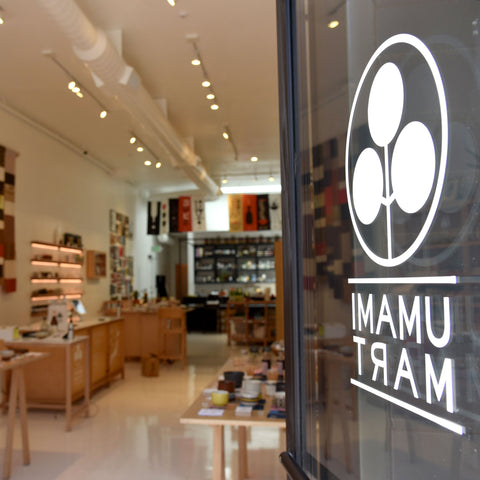
Comments (18)
Hi Ed,
Yes, it’s this one:
http://www.amazon.com/Salton-YM9-1-Quart-Yogurt-Maker/dp/B00004SUHY
Thanks for reading!
Yoko
Yoko – Thanks! I am on my third batch and each time it keeps getting better and better. My real problem has been consistency in temperature so this will definitely help.
I have been making some pretty amazing cookies with it. The recipe cam from who knows originally but I got it from one of my yoga teachers:
2 cups amazake
1 cup flour (or gluten free flour) I used whole wheat from Anson Mills and liked it a lot.
1 cup rolled oats – not quick cooking
1 cup fresh ground peanut butter
1 cup raisins
Mix the amazake and peanut butter together.
In a separate bowl combine all the dry ingredient, add to wet and fold until well mixed.
Fold in the raisins
scoop about 3 Tbsp. mounds onto an un-greased cookie sheet and flatten with a dinner fork. (They are peanut butter after all) and bake.
Be careful to keep the tray in the middle of the oven and turn at about 7 minutes. They should take about 15 minutes or until the bottoms are golden.
The last time I did it I baked them at 350 and used 2 trays but the bottom ones got too dark on the bottom very quickly.
I can’t stop eating them…
I forgot!!! – pre-heat oven to 325
DOV and all~Hi. Please understand that Chinese yeast balls are a completely different fungus than Japanese koji.
If you decide to make rice wine, I would go with sake and not Chinese rice wine. Unless it is unpasteurized Namazake, commercial sake is unlikely to go bad. On the other hand, Chinese rice wine achieves different levels of alcohol and I have had even certain commercial brands go bad to the point of serious food poisoning. It is important to be careful.
Hello,
It is kinda funny, your third attempt you followed the directions that came with the Koji! I just wanted to mention two things that will make it easier and save some money. The Koji is just what you inoculate the rice with, that being said you do not need 2 cups of Koji to one cup of rice. To save money I cook two cups of rice and add one cup of Koji and there is absolutely no difference in taste, none. The incubation takes about 10-14hours and the way I do it is to pack it all the rice and Koji into a 1/2 gallon mason jar and put this into the smallest cooler it will fit in. Then I boil enough water to fill a hot water bottle and put that in the cooler with the mason jar. 10-14 hours later is it done. Doing is this way will extend your Koji by 3 times.
Last year I went to Takayama, Japan with my fiance and tried some Amazake during a nighttime festival in spring, and was pleasantly surprised at how delicious it was! We tried to bring some back but were told it would not do well on the flight back since the bottled brand that we tried needed to be kept chilled. We’ve never forgotten that time and I’m glad I came across this blog to find that it’s fairly easy to make (just like yogurt! Just takes time…)
Do you know if the glass jar is necessary? My yogurt maker came with a reusable plastic (or some form of it) jar. I’ve heard using something like that is bad, as it can retain the bacteria, but so far it hasn’t had any adverse effects on yogurt…
Excellent quality Brown Rice Koji and other fermented food starters (even a brown rice based sourdough starter, tempeh, nigiri for tofu, etc.) can be purchased from www.gemcultures.com in Washington State.
The maven of macrobiotic cooking on the East Coast, Aveline Kushi, taught us to let the koji practically dissolve all the grains which it will do if left to ferment at 110 degrees F for a couple of days or less, so you don’t have so many whole grains.
As regards koji ratio, (see Sean’s post)I recall using much less koji than even a two to one ratio.
A leader in traditional macrobiotic Japanese cooking, Anna Bond published a recipe for Koji [“Amasake”] Pickles in the mid 80’s.
She uses 5 parts [sweet] rice to 1 part koji, & 5
parts water. No salt cooked into the presoaked grain and the koji must be added when the rice is " warm side of hot" to the touch. Once the amasake is made (left to ferment at
Layers of salt-pressed sliced root vegetables are rinsed and patted dry, and then this amasake paste is spread in between the layers.
Kept at room temp for 6-10 days or until the vegetables are translucent, the koji is scraped back into the crock. The pickles are not rinsed and yummied up! “The koji mixture may be reused for pickling, salad dressing or leavening”, says Bond.
Can you tell me where I can buy the koji rice starter online or in Singapore?